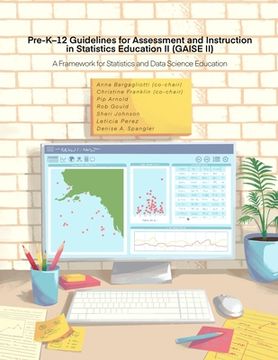Pre-K-12 Guidelines for Assessment and Instruction in Statistics Education II (GAISE II): A Framework for Statistics and Data Science Education (en Inglés)
Reseña del libro "Pre-K-12 Guidelines for Assessment and Instruction in Statistics Education II (GAISE II): A Framework for Statistics and Data Science Education (en Inglés)"
In 2020 as the Pre-K-12 Guidelines for Assessment and Instruction in Statistics Education II: A Framework for Statistics and Data Science Education report (GAISE II) is published, never have data and statistical literacy been more important. The public is being called upon to synthesize information from many global issues, including the COVID-19 global pandemic, a changing planet with extreme weather conditions, economic upturns and downturns, and important social issues such as the Black Lives Matter movement. Data are encountered through visualizations (sometimes interactive and sometimes not), reports from scientific studies (such as medical studies), journalists' articles and websites. The demands for statistical literacy have never been greater. Statistically literate high-school graduate need to be able to evaluate the conclusions and legitimacy of reported results as well as formulate their own analyses. Driven by the digital revolution, data are now readily accessible to statistical methods and technological tools so that students can to gain insights and make recommendations to manage pressing world issues. Data can be extremely valuable, but only if they are used judiciously and in a proper context. Today, many sectors of the economy and most jobs rely on data skills. Good data sense is needed to easily read the news and to participate in society as a well-informed member. Because of this, it is essential that all students leave secondary school prepared to live and work in a data-driven world. The Pre-K-12 GAISE II report presents a set of recommendations for school-level statistical literacy.Overview and Goals of GAISE IIThe Pre-K-12 GAISE I (www.amstat.org/education/gaise) was a seminal and visionary document that championed the necessity of data and statistical literacy starting in the early school grades. It provided a framework of recommendations for developing students' foundational skills in statistical reasoning in three levels across the school years, described as levels A, B, and C. These levels are maintained in GAISE II and are roughly equivalent to elementary, middle, and high school. The progression through the sequential levels in the Pre-K-12 GAISE (both I and II) is intended for any individual who is striving to achieve statistical literacy, regardless of age. GAISE II addresses the evolution of data types and skills needed to make sense of the wealth of data that confronts us. The new updates include:1. The importance of questioning through each stage of the statistical problem-solving process (formulating a statistical investigative question, collecting or considering data, analyzing data, and interpreting results) and how this process remains at the forefront of statistical thinking;2. The consideration of different data and variable types and the importance of carefully designing how primary data are collected or secondary data are considered to answer a statistical investigative question, the process of collecting and cleaning data, the interrogation of data, and the analysis of data;3. The inclusion of multivariate thinking throughout all levels of K-12 education;4. The role of probabilistic thinking in quantifying randomness used by students throughout all school levels;5. The shifts and deepening of the role of technology throughout Pre-K-12 (school level) education;6. The importance of how now, more than ever, statistical information is communicated.GAISE II presents a vision where every individual is confident in reasoning statistically, making sense of data, and knowing how and when to bring a healthy skepticism to information gleaned from data. Presented here is a framework of essential concepts and 22 examples across the three levels of skills development. This framework supports all students as they learn to appreciate the vital role of statistical reasoning and data science and acquire the essential life skill of data literacy.

